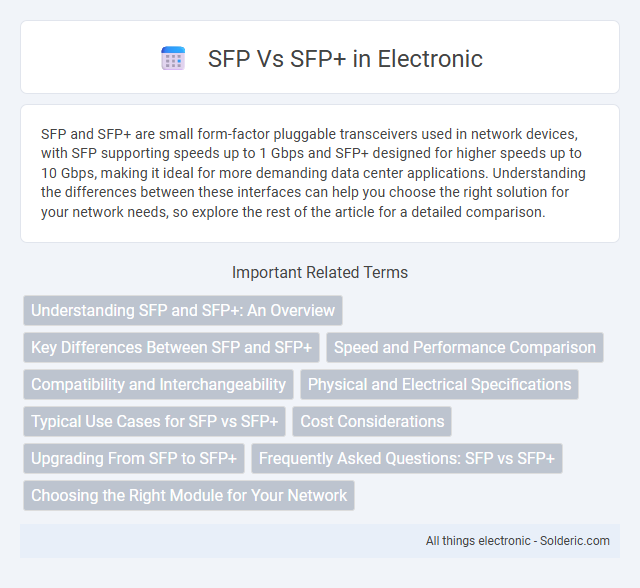SFP and SFP+ are small form-factor pluggable transceivers used in network devices, with SFP supporting speeds up to 1 Gbps and SFP+ designed for higher speeds up to 10 Gbps, making it ideal for more demanding data center applications. Understanding the differences between these interfaces can help you choose the right solution for your network needs, so explore the rest of the article for a detailed comparison.
Comparison Table
| Feature | SFP | SFP+ |
|---|---|---|
| Full Name | Small Form-factor Pluggable | Small Form-factor Pluggable Plus |
| Data Rate | Up to 4.25 Gbps | Up to 16 Gbps |
| Primary Use | 1 Gbps Ethernet & Fiber Channel | 10 Gbps Ethernet & Fiber Channel |
| Form Factor | Standard size, compatible with most network devices | Same size as SFP but supports higher speeds |
| Power Consumption | Approximately 1W | Approximately 1.5W to 2W |
| Cabling | Supports multi-mode and single-mode fiber | Supports multi-mode and single-mode fiber with enhanced signal integrity |
| Compatibility | SFP ports support SFP modules only | SFP+ ports backward compatible with SFP modules |
| Typical Applications | Gigabit Ethernet, Fibre Channel up to 4G | 10 Gigabit Ethernet, Fibre Channel up to 16G |
| Cost | Lower cost compared to SFP+ | Higher cost due to advanced capabilities |
Understanding SFP and SFP+: An Overview
SFP (Small Form-factor Pluggable) and SFP+ are compact, hot-pluggable transceiver modules used in network switches and routers for fiber optic and Ethernet connections. SFP supports data rates up to 1 Gbps, ideal for Gigabit Ethernet applications, while SFP+ enhances performance with speeds up to 10 Gbps, catering to 10 Gigabit Ethernet standards. Both modules share form factor compatibility but differ significantly in bandwidth capacity and use in high-speed data transmission environments.
Key Differences Between SFP and SFP+
SFP (Small Form-factor Pluggable) and SFP+ differ primarily in data transmission speed and supported protocols, with SFP typically supporting speeds up to 1 Gbps for Ethernet and Fibre Channel, while SFP+ supports speeds up to 10 Gbps, enabling faster data handling for high-performance networks. SFP+ also offers enhanced capabilities like support for 10G Ethernet and improved signal integrity through advanced encoding techniques, making it suitable for demanding data center and enterprise applications. Physical dimensions of SFP and SFP+ modules remain similar, allowing backward compatibility, but the electrical interface and performance standards distinguish SFP+ as the preferred choice for high-bandwidth connectivity.
Speed and Performance Comparison
SFP modules support data rates up to 1 Gbps, primarily used for standard Gigabit Ethernet connections, while SFP+ modules deliver significantly higher speeds, reaching 10 Gbps, essential for high-performance networks. SFP+ offers enhanced signal integrity and lower latency, making it suitable for demanding applications like data centers and enterprise backbone networks. The backward compatibility of SFP+ with SFP connectors allows network upgrades without complete infrastructure replacement.
Compatibility and Interchangeability
SFP and SFP+ modules differ primarily in data rates, with SFP supporting up to 1 Gbps and SFP+ up to 10 Gbps, affecting compatibility with network devices. You can use SFP modules in SFP+ slots because SFP+ ports are backward compatible, but SFP+ modules typically require SFP+ or higher-speed ports, limiting interchangeability. Understanding these compatibility nuances ensures optimal network performance and prevents hardware mismatches.
Physical and Electrical Specifications
SFP (Small Form-factor Pluggable) modules typically support speeds up to 1 Gbps and have a maximum power consumption of around 1 watt, while SFP+ modules handle data rates up to 10 Gbps with power consumption closer to 1.5 watts. Physically, both SFP and SFP+ share similar dimensions and form factors, ensuring compatibility with the same slots on network devices. Your choice depends on network speed requirements and electrical capabilities, since SFP+ demands enhanced signal integrity and tighter electrical specifications for higher performance.
Typical Use Cases for SFP vs SFP+
SFP modules are commonly used for 1 Gbps connections in enterprise networks, access switches, and small data centers where moderate bandwidth suffices. SFP+ modules support 10 Gbps speeds, making them ideal for high-performance computing, data center uplinks, and backbone network infrastructure requiring greater throughput. When planning your network, choose SFP for cost-efficient gigabit links, while SFP+ suits demanding applications needing enhanced speed and reduced latency.
Cost Considerations
SFP modules generally cost less than SFP+ due to their support for lower data rates, often making SFP a budget-friendly option for 1 Gbps connections. SFP+ modules, designed for 10 Gbps speeds, tend to have higher prices because of their advanced technology and performance capabilities. Evaluating network needs carefully can help balance cost efficiency with desired bandwidth and future scalability.
Upgrading From SFP to SFP+
Upgrading from SFP to SFP+ significantly enhances your network's data transmission speed, shifting from typical 1 Gbps with SFP modules to 10 Gbps using SFP+ modules. Both form factors share the same physical size, allowing for straightforward compatibility with existing ports, but SFP+ supports higher signal integrity and lower latency, ideal for data centers and enterprise networks. Consider your network infrastructure's capability to handle increased bandwidth when planning the transition to maximize the benefits of SFP+ technology.
Frequently Asked Questions: SFP vs SFP+
SFP (Small Form-factor Pluggable) supports data rates up to 1 Gbps, while SFP+ enhances performance with speeds up to 10 Gbps, making it ideal for high-bandwidth applications. Common questions include compatibility issues between SFP and SFP+ modules, which typically depends on switch port capabilities and vendor specifications. Understanding your network's speed requirements and hardware compatibility ensures you select the right transceiver to optimize connectivity and performance.
Choosing the Right Module for Your Network
Choosing the right module for your network depends on the required data transfer speed and compatibility with existing equipment. SFP modules typically support speeds up to 1 Gbps, while SFP+ modules handle up to 10 Gbps, making SFP+ ideal for high-performance applications. Evaluate your network's bandwidth needs and hardware support to ensure optimal connectivity and future-proofing.
SFP vs SFP+ Infographic

 solderic.com
solderic.com